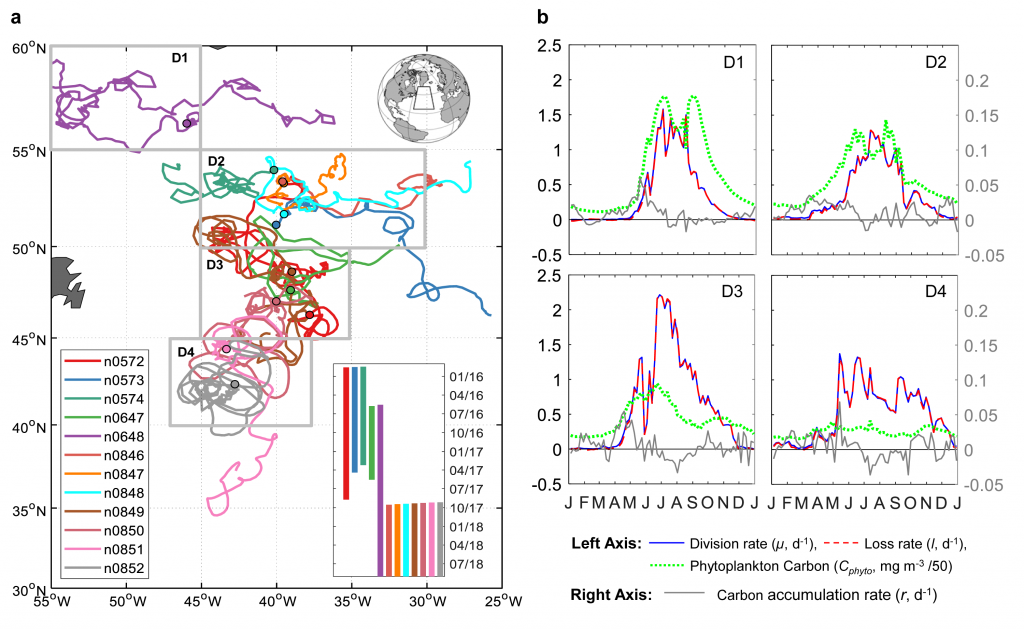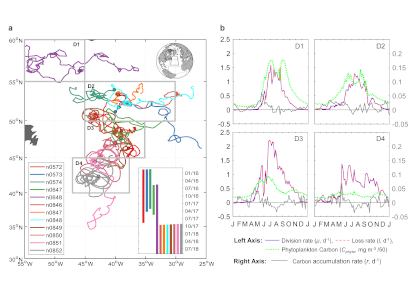Phytoplankton produces organic carbon, which serves as a major energy source in marine food webs and plays an important role in the global carbon cycle. Studies of phytoplankton seasonal timing (phenology) have been a major focus in oceanography, especially in the subpolar North Atlantic region, where massive increases in phytoplankton biomass (blooms) occur during the winter-spring transition.

Figure 1. Panel a: Each line represents the trajectory of a profiling Argo float deployed during the North Atlantic Aerosols and Marine Ecosystems Study (NAAMES) expeditions (12 total); the initial float deployment location is denoted by a filled circle. The bar chart (inset right bottom) indicates float deployment durations. Panel b: Seasonal climatologies of Cphyto (green), µ (blue), l (red), and r (grey) from Argo floats for all 4 regions (D1-D4 as indicated on map in Panel a).
Many hypotheses based on data from shipboard discrete sampling or satellite remote sensing have been proposed to explain drivers of phytoplankton bloom formation and dynamics. However, discrete shipboard sampling limits both spatial and temporal coverage, and satellite approaches cannot provide direct information at depth. To address this gap in spatiotemporal coverage, a recent study in Frontiers in Marine Science, applied bio-optical measurements from 12 Argo profiling floats to study the year-round phytoplankton phenology in a north-south section of the western North Atlantic Ocean (40° N to 60° N). The authors calculated phytoplankton division rate (µ), loss rate (l), and carbon accumulation rate (r) using the Argo-based Chlorophyll-a (Chl) and phytoplankton carbon (Cphyto) estimates. Latitudinally varying phytoplankton dynamics were observed, with a higher (and later) Cphyto peak in the north, and stronger μ–r decoupling and increased proportion of winter to total annual production in the south (Figure 1). Seasonal phenology patterns arise from interactions between “bottom-up” (e.g., resources for growth) and “top-down” (e.g., grazing, mortality) factors that involve both biological and physical drivers. The Argo float data are consistent with the disturbance recovery hypothesis (DRH) over a full annual cycle. Float-based mixed layer phytoplankton phenology observations were comparable to satellite remote sensing observations. In a data-model comparison, outputs from an eddy-resolving ocean simulation only reproduced some of the observed phytoplankton phenology, indicating possible biases in the simulated physical forcing, turbulent dynamics, and biophysical interactions.
In addition to seasonal patterns in the mixed layer, float-based measurements provide information on the vertical distribution of physical and biogeochemical quantities and therefore are complementary to the satellite measurements. This powerful combination of observing assets enhances spatiotemporal coverage, thus enabling us to better observe, compare, model, and predict seasonal phytoplankton dynamics in the subpolar North Atlantic.
Authors:
Bo Yang (University of Virginia)
Emmanuel S. Boss (University of Maine)
Nils Haëntjens (University of Maine)
Matthew C. Long (National Center for Atmospheric Research)
Michael J. Behrenfeld (Oregon State University)
Rachel Eveleth (Oberlin College)
Scott C. Doney (University of Virginia)




